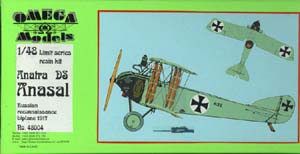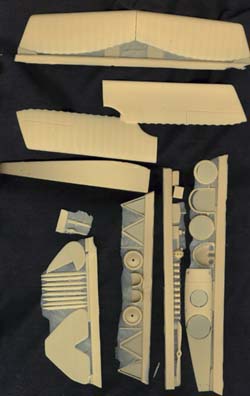Omega Models 1/48 Resin Anatra Anasal |  | Introduction The Anatra Anasal was a development of the earlier Anade, which had entered service in May 1916. The Anasal used a Salmson Canton-Unne Radial engine instead of the 100 hp Monosoupape rotary of the Anade. The Anasal entered service in early 1917, and was found to be comparable to enemy aircraft of similar type. However the Anasal was also difficult to fly, in that it required the full attention of the pilot, or risk losing control. Around 70 were produced, and the type was used postwar by the Czechs as well as captured examples by the Austrians. The kit The only previous model of an Anatra was that produced by Emhar in 1/72 scale. I built that kit a few years ago, and was quite pleased with how it turned out, so it was with interest that I received this kit for review.  All the parts come in the usual divided envelope and are attached to heavy runners. The fuselage is cast with the entire upper decking as a separate piece allowing for a fully detailed interior – the only interior parts molded in place are the bottom crosspieces connecting the longerons. Sidewalls are provided as PE. Dry fitting of the upper decking shows some sanding will be needed to get a good fit. All the parts come in the usual divided envelope and are attached to heavy runners. The fuselage is cast with the entire upper decking as a separate piece allowing for a fully detailed interior – the only interior parts molded in place are the bottom crosspieces connecting the longerons. Sidewalls are provided as PE. Dry fitting of the upper decking shows some sanding will be needed to get a good fit.
Wings are cleanly molded with no bubbles apparent.The upper surfaces of each has somewhat heavy trenches for the ribs, while the undersurfaces are smooth. Some sanding of the uppersurfaces will be required, while the undersurfaces can be represented with decal material or painting. Tail surfaces are flat with no detail added to them, so ribs will need to be added. Luckily there are full drawings included with the kit. There is the usual mulitpart Omega engine, however I am unable to tell if this is an accurate Salmson or not as it looks like a rotary to me The remaining parts are for the struts, wheels, Lewis and Vickers guns, seats, exhaust collector ring, cowl front and radiator.
 The fret of PE is interesting in that it provides the lowest portion of the cowl in brass. This will make a nice thin exposed edge to the front - it will be interesting to see how well it works. Also included on the fret are wheel spokes, louvred panels, radiator fronts, steering wheel, rudder pedals and the inlet valves for the cylinders. The fret of PE is interesting in that it provides the lowest portion of the cowl in brass. This will make a nice thin exposed edge to the front - it will be interesting to see how well it works. Also included on the fret are wheel spokes, louvred panels, radiator fronts, steering wheel, rudder pedals and the inlet valves for the cylinders.
Instructions consist of a two sides sheet showing exploded views of the various parts as well as a separate page with drawings of the aircraft and photos of a preserved example in Prague.  Decals are provided for two machines. The preserved example in Czech markings and an Austrian one with oddly proportioned crosses on round!! fields. I have yet to come across this example, but that doesn't mean it didn't exist. However I have yet to see a photo of a Central Powers aircraft with a round cross field. Decals are provided for two machines. The preserved example in Czech markings and an Austrian one with oddly proportioned crosses on round!! fields. I have yet to come across this example, but that doesn't mean it didn't exist. However I have yet to see a photo of a Central Powers aircraft with a round cross field.
Conclusion An interesting model of a little known type - the person I offered it to to build had never heard of it!!!!! Although the overall detail is pretty basic, the exposed cockpits will allow for a large degree of detail. With a little effort it will turn into a nice addition to any collection. My thanks to Lubos Vinar of Hobbyshop.cz for the review sample | 







|

 All the parts come in the usual divided envelope and are attached to heavy runners. The fuselage is cast with the entire upper decking as a separate piece allowing for a fully detailed interior – the only interior parts molded in place are the bottom crosspieces connecting the longerons. Sidewalls are provided as PE. Dry fitting of the upper decking shows some sanding will be needed to get a good fit.
All the parts come in the usual divided envelope and are attached to heavy runners. The fuselage is cast with the entire upper decking as a separate piece allowing for a fully detailed interior – the only interior parts molded in place are the bottom crosspieces connecting the longerons. Sidewalls are provided as PE. Dry fitting of the upper decking shows some sanding will be needed to get a good fit. The fret of PE is interesting in that it provides the lowest portion of the cowl in brass. This will make a nice thin exposed edge to the front - it will be interesting to see how well it works. Also included on the fret are wheel spokes, louvred panels, radiator fronts, steering wheel, rudder pedals and the inlet valves for the cylinders.
The fret of PE is interesting in that it provides the lowest portion of the cowl in brass. This will make a nice thin exposed edge to the front - it will be interesting to see how well it works. Also included on the fret are wheel spokes, louvred panels, radiator fronts, steering wheel, rudder pedals and the inlet valves for the cylinders. Decals are provided for two machines. The preserved example in Czech markings and an Austrian one with oddly proportioned crosses on round!! fields. I have yet to come across this example, but that doesn't mean it didn't exist. However I have yet to see a photo of a Central Powers aircraft with a round cross field.
Decals are provided for two machines. The preserved example in Czech markings and an Austrian one with oddly proportioned crosses on round!! fields. I have yet to come across this example, but that doesn't mean it didn't exist. However I have yet to see a photo of a Central Powers aircraft with a round cross field.






